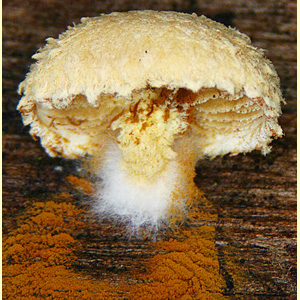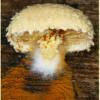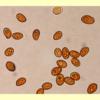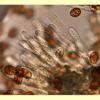
images/Pleuroflammula_praestans/Phaeomarasmius_sp_BOU357.jpg

_(2)_sml.jpg)


Diagnostic characters
Small agaric, growing on litter or wood, with a rusty brown spore print. Pileus yellow to brown, not viscid, not hygrophanous. Lamellae adnate or adnexed. Stipe lateral or excentric. Partial veil remnants a ring zone or membranous annulus. Spores orange-brown, smooth; germ pore absent. Cheilocystidia present. Lamellar trama regular. Pileipellis a cutis or trichoderm with branched terminal elements. Clamp connections present.
Similar genera
Among genera with an excentric to lateral stipe and rusty-brown spore print that grow on wood, Pleuroflammula praestans is distinct due to the combination of a dry, non-translucent-striate pileus, a partial veil and smooth spores. In addition, fragments of lamellae mounted in 3% KOH release yellow pigment. Gymnopilus has rough spores, and its fruit-bodies are often large. Smooth-spored species of Galerina have a hygrophanous, translucent-striate pileus that lacks scales. In Pholiota the pileus is viscid or glutinous and the spores have a germ pore. Pleuroflammula praestans is distinguished from smooth-spored species of Crepidotus by the presence of a veil that leaves an annulus or ring-zone.
Citation
Pleuroflammula Singer, in Singer & Smith, Mycologia 38: 521 (1946).
Australian species
One species: Pleuroflammula praestans.
Citation of species
Pleuroflammula praestans E.Horak, Persoonia 9: 445 (1978).
Australian distribution
W.A., S.A. (and possibly also in eastern states).
Habitat
In native forests.
Substrate
On litter or wood.
Trophic status
Saprotrophic.
References
Bougher, N.L. (2009a), Fungi of the Perth region and beyond: a self-managed field book, Western Australian Naturalists' Club (Inc.), Perth. [Description and Illustration of P. praestans]
Bougher, N. (2011), Perth urban bushland fungi team, Perth fungi in 2010, Fungimap Newslett. 42: 14–15. [Illustration of P. praestans]
Horak, E. (1978b), Pleuroflammula, Persoonia 9: 439–451. [Key, Description, B&W Illustration and Microcharacters of ten species of Pleuroflammula including New Zealand collections of P. praestans]
